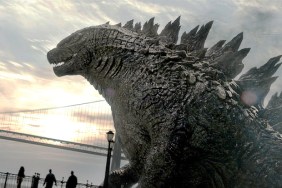Godzilla vs. Biollante


Release Date: 16th December 1989
Monster: Biollante
Description: Viny, thorny tree-like rosebush with an alligator head and acid-spitting tentacles.
Origin: A rosebush is grown to massive size and aggression when it is genetically cross-bred with Godzilla cells.
Destruction: Godzilla kills it. Like a boss. Then the military kill Godzilla.
Actor(s): Masashi Takagumi (Biollante), Kenpachiro Satsuma, Yoshitaka Kimura, Shigeru Shibazaki (all Godzilla)
Like All Monsters Attack and Godzilla vs. Hedorah, Godzilla vs. Biollante feels like an aberration in the series. For one, it’s the longest of the films to date, running a healthy 105 minutes. It’s also plotted far differently. I think the series is still trying to find its feet after the reboot, deciding on what kind of tone they want to go with, whether it be fun and goofy, dark and stern, or something else entirely. It’s hard to tell what Godzilla vs. Biollante was trying to go for.
Clearly it was trying to be topical with all its talk of genetics and geneticists trying to investigate what Godzilla is truly made from. It was also trying to establish a more solid sense of continuity by introducing human characters that would eventually appear in most of the films of the Heisei era. The character of Miki (Megumi Odaka), for instance, will bear witness to all of Godzilla’s adventures through 1995, and will actually play a crucial role in predicting where Godzilla will strike next. Miki, you see, is a psychic who was discovered at a psychic research laboratory on the outskirts of Tokyo, and is employed by increasingly powerful government agents to intuit Godzilla specifically. That’s a plum job, if you can get it. Miki is a sweet and innocent girl, and will play the function that was previously held by a rotating bevvy of reporters in the earlier Godzilla movies.
So there have been psychic vibrations all over Tokyo that Godzilla, imprisoned in a volcano for the last five years, is about to break free. Not even five years of molten rock can stop the big guy. At the same time, a kind geneticist (Kunihiko Mitamura) has been tinkering with the very fabric of life, attempting to make something or other. In a flashback, we learn that he once tried to make something out of Godzilla cells, but ended up killing his beloved with the result (evil terrorists tried to kill her to get at his research), so he has sworn off tinkering with Godzilla, preferring to stick to botany. Eventually, of course, he will be enlisted to do more personally tragic Godzilla research, and he will be the one to accidentally fuse Godzilla cells with a rose plant he had in his lab. The result is Biollante, a stories-high rose plant with living tentacles that bite people with thorny teeth. At first, Biollante is a stationary tree growing out of a lake that only occasionally lashes out at people with its long tentacles, but eventually changes into a mobile plant beast with an alligator-like head.

Is it me, or is a giant mutant rosebush a really lame idea for a monster? I know that you’ve exhausted your supply of giant crabs, giant spiders, mantises, dragons, sea serpents, dinosaurs, and whatever the heck King Caesar was, but do you really have to try to make monstrous a notoriously gentle and romantic thing as a rose? I suppose the message here is that genetics, if unchecked, can turn even something as sweet and unassuming as a rose into a giant gnashing pain monster. When Godzilla escapes from his volcano prison – newly redesigned to look more monsterish than ever) – he beelines straight to Biollante to rip her to shreds. Godzilla is territorial, and cannot abide by other monsters – especially those with his DNA – anywhere on the planet. The rip-apart, though, only makes Biollante mad, and she mutates into a mobile tentacled alligator rose. ‘Nother monster fight ensues.

Oh shoot, and I should probably mention an entire plotline devoted to evil terrorists from the country of “Saradia” who are trying to get Godzilla DNA for their own purposes, and who play a major role in the film. I was so bored and confused by this baffling terrorist storyline, though, that it’s hardly worth mentioning for any reason other than critical integrity. There is an evil guy with guns running around in the margins. I should also perhaps mention the creation of Super X2, the souped-up model of the Super X from the last movie. The Super X2 is an ominous airship with the ability to reflect Godzilla’s breath back at him using a complex diamond shield. Super X2 looks and feels a lot like the floating green Thunderbird 3 from Gerry Anderson’s famed cult puppet series. I appreciated all the stuff surrounding Super X2. It turns out, though, that Super X2 isn’t really much of a match for Godzilla, burning out its reflecting weapon after only about a dozen hits.
Also, the classic Godzilla theme music is used in this film, only it’s a funkified disco version. Which is so goofy, it’s hard to listen to without bursting out laughing. Which is what I did.
Godzilla vs. Biollante is kind of lame, and feels like growing pains. Clearly the series is trying to do something new, but it’s still caught under the Godzilla legacy. Luckily for us, the next movie in the series will be an merciful return to the gooftastic days of yore, as it will not only re-introduce King Ghidorah into the mix, but also has a hefty amount of time travel. Let’s look at…








